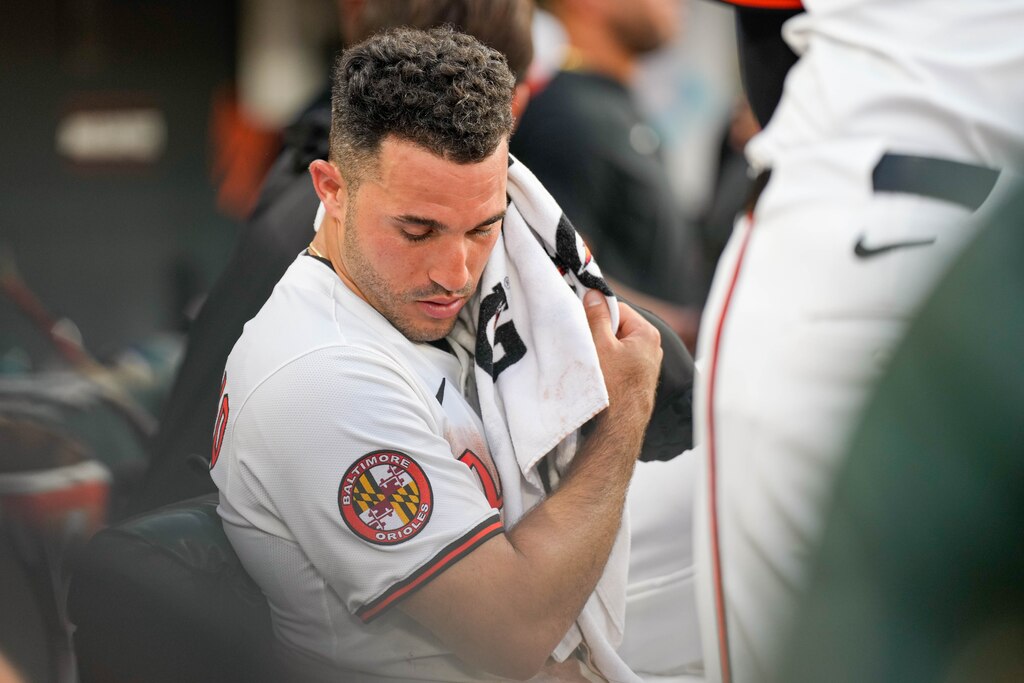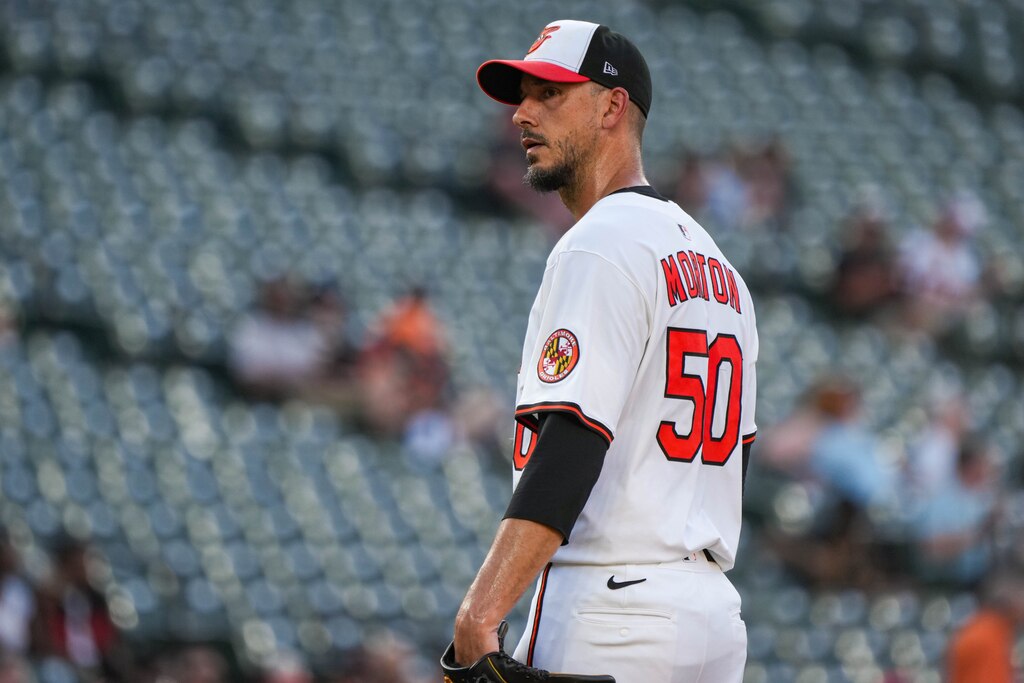CLEVELAND — It took Mike Elias a while to get to this point, but the Orioles general manager officially acknowledged that Baltimore will be a seller at this year’s trade deadline.
Read More
During an appearance with MLB Network Radio on SiriusXM this weekend, Elias said, “We’ve got to be realistic about our situation.” There is little more than a week before the July 31 trade deadline. The Orioles are 8.5 games back of an American League wild-card spot and have lost six of their last seven games. Reality is here, and it means trading pieces that were expected to be a part of postseason baseball.
“We’re not blowing up the team,” Elias said. “We think we’re going to be very good again in 2026 and have that intention. We’re not interested in changing the foundation of the team, but to the degree that we have players that interest other clubs, who are coming towards the end of their contracts, we’ve got to listen to that. That’s what we’re spending our time on now.”
The Orioles have nine impending major league free agents. They have 12 pieces to deal if they make players with options in their contracts for the 2026 season available (those options could increase the return, because a buying team has the choice of retaining a player longer). Catcher Jacob Stallings likely has very little value and long-term injuries to infielder Jorge Mateo and catcher Gary Sánchez mean they’re unlikely to move, so the Orioles realistically have nine players they could conceivably move ahead of the deadline.
In all likelihood, Baltimore won’t trade all of them. The returns won’t be enough in some cases, and the Orioles need to field a team the rest of the way.
Still, we wondered about the best fit for each of the nine players who could be on the move. We gathered insights from scouts, front office officials and baseball writers.
First base

Ryan O’Hearn is one of the most coveted bats at the deadline. The first baseman and corner outfielder has flourished from a feel-good story into a legitimate basher and All-Star. And, with an expiring contract, he is an inexpensive choice for many teams looking to add for the stretch run and the postseason.
According to a source with direct knowledge, the following teams have expressed interest in O’Hearn’s services: the Seattle Mariners, San Diego Padres, Milwaukee Brewers, Texas Rangers, Houston Astros, San Francisco Giants and Boston Red Sox.
The interest is so widespread because O’Hearn can fit the needs of many lineups. He has an .828 on-base-plus-slugging percentage, and he has mashed right-handed pitching with a .294 average and .878 OPS. Of all the interested teams, it’s hard to pick one team as the best fit. Here it is, anyway.
Best fit for O’Hearn: Padres
Why? For as well as Luis Arraez hits for average, he brings little to no power to the equation. Padres first basemen this season have combined for a .662 OPS, which is 22nd in baseball. Arraez also ranks in the second percentile in range, with negative-7 outs above average, according to Statcast. O’Hearn provides all-fields power and better fielding (5 outs above average at first). He can also move around defensively and at DH, which makes it easier to incorporate him in any lineup.
Outfield

Ramón Laureano, not Cedric Mullins, might bring the most value back to the Orioles in a trade. However, Laureano’s team-friendly $6.5 million club option for 2026 might disincentivize the Orioles from moving him, considering Laureano could play a part in what Elias hopes is a competitive 2026 squad.
Mullins is an interesting player to consider. His 13 home runs are tied for the most on the Orioles, although most of those came earlier in the season. He’s a streaky hitter, and his latest downturn leaves him with a .180 average since May. Still, Mullins is a solid center fielder on an expiring contract, and even though the advanced defensive metrics show the 30-year-old has taken a step back this year, his track record would suggest he can revert to the mean.
Laureano, meanwhile, can play all three outfield positions and is hitting .279 with an .861 OPS. He is especially crushing right-handed pitching with a .925 OPS.
Best fit for Mullins: Phillies
Why? There’s no guarantee Philadelphia will add a bat, but it ranks 25th in baseball with a .613 OPS from its center fielders. Mullins wouldn’t do much to raise that; his .689 OPS this season is buoyed by early success compared to his .561 OPS since May. But Mullins has the ability to break out of his funk at any time while also giving outfield prospect Justin Crawford more time to develop in Triple-A.
Best fit for Laureano: Padres
Why? The Padres tend to be aggressive at the deadline, and they need help in the outfield as they look to hold on to their wild-card spot. San Diego has a hole in left field that Laureano could fill. The Padres’ left fielders have combined for a .608 OPS. Laureano can fix that.
Starting pitcher

A few months earlier, Tomoyuki Sugano and Zach Eflin appeared to be the best starters the Orioles had to offer. Instead, it’s Charlie Morton — although the seven earned runs he allowed in 5 1/3 innings last week against the Tampa Bay Rays looked more like the early-season Morton.
Morton held a 9.76 ERA on May 4. He was removed from the rotation briefly that month. But, since he returned as a starter May 26, Morton’s ERA is 3.78 in nine games. His value is increased because of his experience as a two-time World Series winner; a contending team gains a workhorse and clubhouse leader in one.
Eflin, who is expected to return this week from a back strain, has struggled for much of this season. He holds a 5.95 ERA. And while Sugano, in his first season of Major League Baseball, got out to a strong start, his performances since have likely reduced his trade value. Sugano’s ERA since June is 6.69.
In that sense, there might be no real market for Eflin and Sugano. But here are potential fits anyway.
Best fit for Morton: Astros
Why? A return to the place that resurrected Morton’s career. Framber Valdez and Hunter Brown are putting together terrific seasons, but the success of Houston’s starting staff falls off from there. Morton could act as a stabilizer, even if he’s not the most in-vogue name, such as Sandy Alcantara or Zac Gallen.
Best fit for Eflin: Yankees
Why? Why not? New York could use another starting pitcher as it battles the Toronto Blue Jays for the top spot in the American League East. Eflin’s knowledge of the AL East is a double-edged sword. He knows his opponents well. They know him, too. Plus, for a team that has lost multiple starters to injury, Eflin’s two IL stints this season won’t make him the most attractive addition.
Best fit for Sugano: Cubs
Why? With Justin Steele out for the season, Chicago could use an additional rotation piece. It isn’t the Cubs’ primary trade deadline concern, but acquiring Sugano might not take major prospect capital, and while he lacks the sort of swing-and-miss stuff teams love in the postseason, the class of starting pitchers available is considered light.
Relief pitcher

The Orioles have already traded one reliever, right-hander Bryan Baker, to the Tampa Bay Rays. Relievers are coveted assets at the deadline, and Baltimore has more who will likely be on the move.
Although closer Félix Bautista will be of interest, Elias’ stated goal of competing in 2026 would seem to exclude the right-hander from trade consideration unless the Orioles are blown away by an offer. Bautista is under team control through 2027.
The more likely targets are right-hander Seranthony Domínguez and Andrew Kittredge and left-hander Gregory Soto. Domínguez, according to three scouts for National League clubs, will draw the most trade interest of that trio. He sports a 3.63 ERA and is primarily used in high-leverage roles.
As a southpaw who can reach triple digits on his fastball, Soto will also attract suitors. He holds a 4.08 ERA and 1.33 WHIP. And, despite limited usage this year due to knee surgery in spring training, Kittredge has been solid. He was a premier setup man for the St. Louis Cardinals last year, and with a 3.76 ERA in 26 1/3 innings this year, Kittredge can be used in tight situations.
Realistically, every buying team will make phone calls to Elias about these three relievers.
Best fit for Domínguez: Blue Jays
Why? Toronto has a chance to win the American League East, and the Blue Jays will be aggressive on the trade market for pitching. A starter might be their top priority, but adding a late-inning reliever is never a bad choice.
Best fit for Soto: Tigers
Why? Detroit’s bullpen has been solid but is missing one aspect: a strikeout pitcher. Of the relievers who have thrown 20 or more innings this season, only two, closer Will Vest and lefty Brant Hurter, are averaging more than a strikeout per inning. There’s value in the punchout, and despite Soto’s occasional command issues, he has 42 strikeouts in 35 1/3 innings.
Best fit for Kittredge: Phillies
Why? Philadelphia’s 4.27 bullpen ERA ranks 23rd in baseball. Last year, the Phillies and Orioles connected on two trades that sent Soto and Domínguez to Baltimore. This time, they could connect again for one of the Orioles’ three relievers. Kittredge is the only one who didn’t just pitch for Philadelphia, so he gets the nod here.




Comments
Welcome to The Banner's subscriber-only commenting community. Please review our community guidelines.